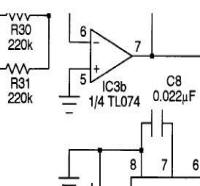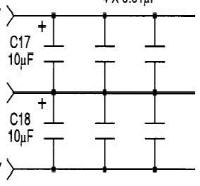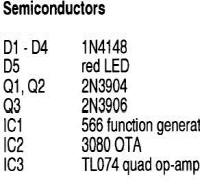The UD-1 Drum Voice Project
A Versatile Drum Voice Design
The UD-1 Drum Voice employs the use of an NE566 or LM566 VCO IC - one of those ever so useful (and thus discontinued by the 'shirts' in corporate electro-land) ICs. If you have one or two sitting around without a use, here is a dynamite little application for it. Finding a 566 can be quite difficult - they show up on on-line auction from time to time, and there appears to be a NTE replacement for it as well - the NTE994m. While you're thinking about that, the UD-1 also makes use of the CA3080, another recently discontinued IC, but not nearly as hard to find as the 566.
The UD-1 Drum Voice
Anyone familiar with Thomas' ADV Bass design will recognize the basic architecture of the UD-1 Drum Voice. The UD-1 has an input for pulse, which it uses to 'fire' the drum voice, and, of course an output. Thomas added one more valuable input to the UD-1 - voltage control of the pitch of the drum voice.
The UD-1 allows the user to program the desired drum by breaking the components of percussive sounds into individually controllable parameters.
First of all, we start with the sound of the drum stick striking the drum head - the impact tone. The UD-1 allows the user to select how loud the impact will be. The UD-1 also allows the user to set how how sharp the impact tone will be. For example, the sound of a drum stick striking a woodblock will have a sharper sound than the same drumstick hitting a tom.
Next we concentrate on the pitch of a drum. The pitch of a drum is determined by the shell or body of a drum. Obviously a bass drum has a lower pitch than a tom. The UD-1 allows the user to set the initial pitch of the drum, but it has something a bit extra - it allows voltage control of the pitch as well! More on that in a bit.....
The UD-1 allows the user to select the waveform used by the simulated percussive instrument. A bass or a tom sound will normally use a triangle waveform, while a woodblock or clave sound may use a square wave. The UD-1 provides a control that fades between full triangle wave to full square wave so that one can tweak in the exact waveform needed to produce the desired percussive sound.
Some percussive voices will have a longer decay than others - for example, a woodblock will decay more quickly than a bass or tom. The UD-1 allows the user to set the duration of the drum sound with the Decay control.
When a drumhead is struck, the drum head and even the shell of the drum flexes. This produces a pitch shift in the drum each time it is struck - it will 'flex' briefly to a higher pitch and will quickly lower in pitch over time. The UD-1 allows the user to adjust how much, if any, pitch shift there is each time the drum is 'struck'.
CCombining these parameters together allows the user to program a wide range of quite realistic drum effects. One can produce bass, tom, woodblock, clave, and other sounds quite easily with the module. In fact, with the variable decay and pitch bend, it's easily possible to produce those disco-era-killing electronic drum sounds - if one must =0).
The voltage controlled pitch function particularly expands the usability of the drum voice. For example, I've found it possible to use a keyboard and create a drum kit made up of pitched toms or woodblocks. The voltage control of the pitch is not a volts/octave arrangement, but it's quite serviceable for percussive sounds.
Sound Sample
I have a hard time making samples of the UD-1. To really do it justice, I would like to sequence it with other parts, but my sequencers were taken off breadboard to make room for other projects. Right now I've got another on breadboard and will try the UD-1 with it, but as of this writing, I only have one sample available.
The sample was taken off of the tail end of a really cheesey recording I made of a patch that used the UD-1. I basically had a VCO, the SN-Voice and the UD-1 all controlled from my keyboard. Hit a note, and the UD-1 fires while the VCO and SN-Voice follow it. While the musical content of the sample is questionable, it certainly demonstrates the sound of the UD-1 in a tom configuration following the CV of my keyboard.
UD-1 Drum Voice Schematics and Part List
Circuit Theory
The UD-1 is a classic example of Thomas Henry's talent for balancing maximum degree of performance and economy of design. It contains three integrated circuits, yet provides an extremely effective and highly configurable drum voice module.
When a short pulse is applied to the trigger input, it first is processed by a comparator built around IC3A. The reference voltage of this comparator is adjustable (the sensitivity control) so that a wide range of trigger amplitudes can be accomodated.
When the comparator pulse goes high, it illuminates the Status LED. Because fo the short duration of the pulse, C9 is provided to stretch this pulse out so that the LED does not react so fast that one cannot see it. The pulse signal from the comparator is then sent to two separate sections of the circuit. The first section generates the impact tone. This section of the circuit has a tone circuit, built around C10-11 and R6, R10 and R14 to provide tone control of the impact signal. This modified signal is then sent through C13 to R21, which adjusts the amplitude of the impact tone.
The other section the comparator pulse goes to is used to generate the envelope signal. C12 , R2 and R32 provide the means to stretch this short pulse into a longer, audible decay signal, with R32, the Decay control, providing a means to program how long it takes the envelope signal to fall to its lowest level.
The envelope signal produced in this section is used to control (A) the amplitude of the shell signal and (B) the dynamic frequency sweep of the shell signal as well.
IC1 produces the shell signal. The 566 is set to provide both square and triangle wave outputs. Either of these two waveforms, or a blend of them, are provided through R33, the Blend control. The frequency of the waveforms produced by IC1 is controlled by three different signals: the intial frequency control, the external control voltage, and the envelope signal delivered from the Sweep pot, R13. The blend of triangle and square wave is delivered to the input of IC2, a CA3080 that is acting as a voltage controlled amplifier.
The envelope signal is applied to the control input of IC2, thus controlling the amplitude of the square/triangle wave signal. This signal is converted to a voltage by IC3C and delivered to R25, the shell volume control.
The impact signal and shell volume signal are then mixed by IC3d and associated components, and are sent through the Master Volume Control to the output of the UD-1 Drum Voice module.
UD-1 Connectors and Controls
| Trigger Input J1 | Adjustment of the Decay Control allows the user to set the duration, or envelope, of the generated drum sound once an input trigger is detected. For example, a woodblock will have a very, very short decay, while a tom will have a longer decay. |
| CV Input J2 | The CV Input jack accepts a control voltage and is used to dynamically control the pitch of the drum voice. |
| Output J3 | The Output jack outputs the programmed drum voice with each pulse applied to the Trigger Input. |
| Sensitivity Control | The sensitivity control allows one to adjust how sensitive the Trigger Input is - this allows the user to adjust the pulse level that will fire the UD-1. This provides a greater range of trigger level that can be used with the UD-1. For example, my keyboard puts out a 0 to 5V trigger, but other systems may put out larger or smaller triggers. |
| Impact Volume Control | The Impact Volume Control allows one to adjust how loudly the impact of the simulated drum stick is in relation to the rest of the sound. |
| Impact Tone Control | The Impact Tone Control allows one to adjust the timbre of the impact tone itself. It provides a variable control between bass and treble. The treble area provides a sharper sound, such as a stick striking a woodblock, while the bass area of adjustment provides a lower, more thud-like impact, often associated with bass drums. |
| Decay Control | Adjustment of the Decay Control allows the user to set the duration, or envelope, of the generated drum sound once an input trigger is detected. For example, a woodblock will have a very, very short decay, while a tom will have a longer decay. |
| Initial Pitch Control | The Initial Pitch Control sets the intial or 'resting' shell pitch of the programmed drum voice. If no sweep is programmed into the UD-1 settings, or no control voltage is sent to the UD-1, the pitch of the programmed drum will stay at the setting of this control throughout the entire event of each note produced when a trigger is detected on the Trigger Input. |
| CV Range Control | The CV Range Control determines how much of an effect, if any, the control voltage applied to the Control Voltage input will have on the pitch of the UD-1. |
| Sweep Control | The Sweep Control allows one to adjust how much pitch bend is required to produce a particular drum sound. For example, a tom will start out slightly high in tone and fall immediately. The pitch sweep is controlled by the decay signal, so it follows the decay of the drum sound, starting out high and dropping in pitch along with the envelope. The Sweep Control adjusts how much effect the decay signal has on the pitch of the UD-1. |
| Shell Volume Control | The Shell Volume Control allows the user to adjust the relative loudness of the shell volume. |
| Blend Control | The Blend Control allows the user to adjust the waveform used for the shell portion of the UD-1. At one extreme of the control's setting, a triangle wave is produced. At the opposite extreme of the control's setting, a square wave is produced. The range in between the two extremes provides a crossfade between triangle wave and square wave. |
| Master Volume | The Master Volume Control allows one to adjust the total amplitude of the UD-1 output. At full level, the UD-1 output is around 10Vp-p. This control can be used to attenuate the signal down for devices not equipped to handle synth level signals. |



